mchec.org – The African Marigold, scientifically known as Tagetes erecta, is a vibrant and hardy annual that brings stunning color to gardens and landscapes. Known for its large, pom-pom-like blooms in shades of yellow, orange, and gold, the African marigold is a popular choice for gardeners who want bold, long-lasting flowers with minimal effort. Native to Mexico, these marigolds are widely cultivated for their ability to thrive in hot, sunny climates and their many benefits for gardens.
Features of the African Marigold
- Large, Eye-Catching Blooms: One of the most notable features of the African marigold is its large, showy flowers, which can reach up to 4 inches in diameter. These blooms appear in warm, bright colors like orange, yellow, and gold, creating a striking contrast in the garden. African marigolds are known for their full, round flower heads, which resemble pom-poms or chrysanthemums.
- Long Blooming Season: African marigolds have a long flowering period, typically blooming from early summer through to the first frost. This extended blooming time makes them a valuable addition to flower beds and borders, providing consistent color throughout the growing season.
- Drought and Heat Tolerant: African marigolds are well-suited to hot, dry climates. Their ability to tolerate drought and thrive in full sun makes them a low-maintenance option for gardeners in regions with warm temperatures and limited rainfall.
- Pest Deterrent: African marigolds are known for their ability to repel certain pests, making them an excellent companion plant in vegetable gardens. Their scent is thought to deter harmful insects like aphids, nematodes, and whiteflies. As a result, many gardeners plant African marigolds near crops such as tomatoes, peppers, and beans.
- Attractive Foliage: In addition to their beautiful flowers, African marigolds have finely divided, dark green foliage that adds texture and depth to the garden. Their leaves have a mildly pungent aroma, which contributes to their pest-repelling properties.
- Tall, Upright Growth: African marigolds tend to grow taller than their French marigold counterparts, reaching heights of 12-36 inches, depending on the variety. Their upright growth habit makes them ideal for the back of borders, as they provide height and structure to garden displays.
Growing and Caring for African Marigolds
- Sunlight: African marigolds thrive in full sun and should be planted in areas that receive at least six hours of direct sunlight daily. They perform best in sunny conditions and produce the most abundant blooms with plenty of light.
- Soil: These marigolds prefer well-drained soil but can tolerate a variety of soil types, including sandy or clay soils. Ensure the soil drains well to prevent root rot.
- Watering: While African marigolds are drought-tolerant, they still need regular watering, especially during dry spells or when first planted. Water them deeply but allow the soil to dry between watering sessions to avoid waterlogged roots.
- Fertilizing: African marigolds do not require heavy feeding but benefit from light fertilization during the growing season. A balanced fertilizer can be applied once or twice a season to encourage healthy growth and abundant blooms.
- Deadheading: Removing spent flowers (deadheading) encourages new blooms and helps keep the plant looking tidy. Regular deadheading ensures continuous flowering throughout the season.
Uses of African Marigolds in the Garden
African marigolds are versatile plants that can be used in a variety of garden settings. They are ideal for flower beds, borders, and containers, providing a burst of color that complements other flowering plants. Their tall stature makes them perfect for creating height in garden displays, while their bold, cheerful blooms make them an eye-catching addition to mass plantings.
African marigolds are also commonly used in companion planting. Their ability to repel pests makes them valuable in vegetable gardens, where they help protect crops from harmful insects. Additionally, they are a popular choice for pollinator gardens, as their bright colors attract bees, butterflies, and other beneficial pollinators.
Conclusion
The African Marigold is a standout annual that offers gardeners a winning combination of vibrant color, easy maintenance, and pest-repelling benefits. With its large, showy blooms, drought tolerance, and long-lasting flowers, this marigold variety is perfect for sunny gardens and landscapes. Whether used as a border plant, in containers, or as part of a companion planting scheme, the African marigold is a beautiful and reliable addition to any garden.

